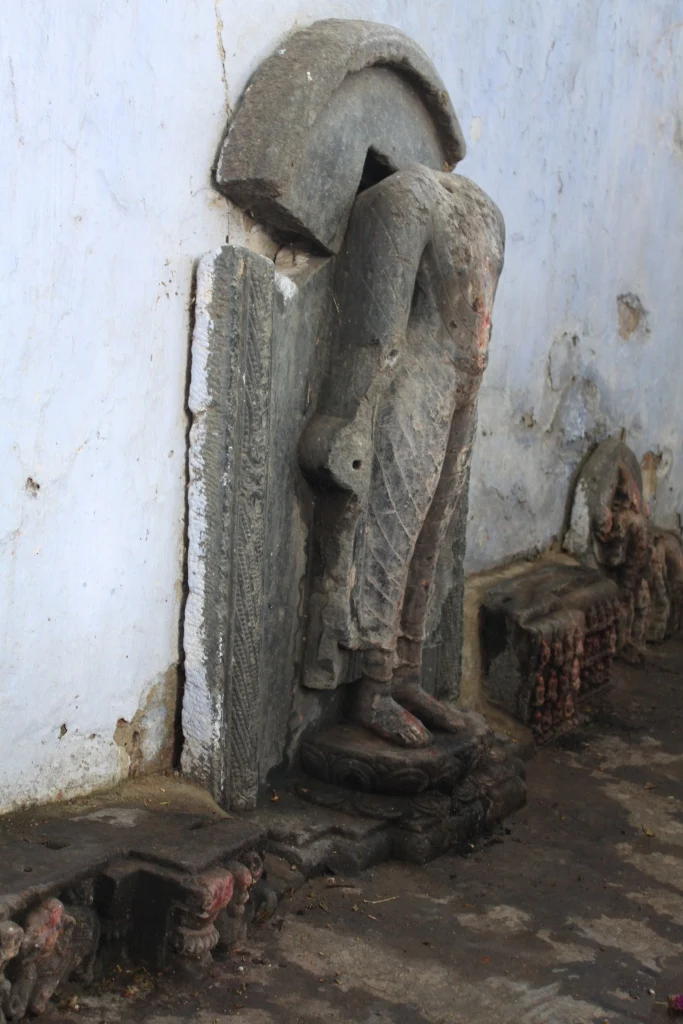In 1174 BE (631 CE), the Chinese monk Xuanzang (Hsüan-tsang) undertook his famous pilgrimage to India in search of sacred Buddhist sites and authentic scriptures. As he traveled from Sāvatthī toward Kapilavastu, he recorded encountering an ancient Buddhist site associated with Kāṇakamuni Buddha (พระโกนาคมนะ), one of the past Buddhas.
Xuanzang wrote:
“From the birthplace of Buddha Kakusandha, going northeast for 30 li, one reaches another great ancient city—the birthplace of Buddha Kanakamuni. In front of it is a stone pillar, over 20 chhieh high, with a carved lion on top. An inscription beside it records the deeds of that Buddha. King Ashoka erected it.”
(Tang Xiyuji, vol. 2, p. 238; translated by Siu Sūlun)
Archaeological Discovery:
In 1893 CE (2436 BE), a Nepalese archaeologist rediscovered the remains of Ashoka’s pillar at a site called Niglisagar (or Niglihawa), located about 30 km northwest of Lumbinī, the birthplace of the historical Buddha, in present-day Nepal.
-
One fragment was the base of the pillar.
-
Another fragment, later found lying beside a pond, was the inscribed shaft.
-
The inscription was copied and sent to the Asiatic Society, where scholars successfully translated the Brāhmī script.
The Inscription (transliteration in modern Devanagari):
Translation:
“In the 14th year of the reign of King Piyadasī, Beloved of the Gods, he came and worshipped here and had a stupa of the Buddha Kanakamuni constructed. In the 20th year of his reign, he visited again and caused this stone pillar to be erected.”
Key Significance:
-
Two visits by King Ashoka are recorded:
-
14th regnal year – constructed the stupa.
-
20th regnal year – returned and erected the stone pillar.
-
-
Ashoka, known for spreading Buddhism across the Indian subcontinent, commissioned these acts to honor past Buddhas as part of his broader religious devotion and political message of Dharma.
-
The inscription explicitly connects King Ashoka with Buddha Kanakamuni, confirming Xuanzang’s 7th-century report.
The Site – Niglihawa (Niglisagar):
-
Located in present-day Nepal, near the border with India.
-
Roughly 30 kilometers northwest of Lumbinī, following Xuanzang’s route.
-
The name Niglisagar likely derives from “Nigali”, the name of the ancient Nigali people or village, and “sāgara”, meaning pond.
Today, the site features:
-
A stupa mound
-
The remains of the Ashokan pillar
-
Ongoing pilgrimage activity and scholarly attention
Conclusion:
This discovery is archaeologically invaluable, as it:
-
Corroborates ancient travel records—specifically Xuanzang’s travelogue.
-
Demonstrates Ashoka’s devotion not only to Śākyamuni Buddha, but also to past Buddhas like Kanakamuni.
-
Offers a rare inscription in early Brāhmī, with royal and religious context tied to actual geographical sites we can still visit today.
“Nearly 2,300 years later, a stone pillar and a foreign pilgrim’s journal meet again to confirm the legacy of a great emperor and a timeless Dharma.”













.jpg)



